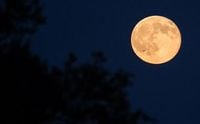On Friday, May 9, 2025, the moon is in its waxing crescent phase, a time when its visibility gradually increases as it moves toward the full moon. This lunar phase marks an exciting period for astronomy enthusiasts and casual observers alike, as it offers a beautiful sight in the night sky.
The waxing crescent moon first appeared on May 4, 2025, at 10:51 AM, and will reach its full phase on May 12, 2025, at 1:55 PM. Following the full moon, the lunar cycle will transition into a waning gibbous phase, which will occur on May 20, 2025, at 8:58 AM, before culminating in a new moon on May 27, 2025, at 12:02 AM.
The average duration of a lunar cycle is approximately 29.5 days, a rhythm that has fascinated humanity for centuries. This cycle consists of four main phases: new moon, waxing crescent, full moon, and waning gibbous, alongside four intermediate phases. Each phase lasts about 3.6 days, contributing to the overall cycle.
The moon, Earth’s natural satellite, does not emit its own light; instead, it reflects sunlight, creating the various phases we observe. The interaction between the moon, the Earth, and the sun is what gives rise to these phases, each characterized by different levels of illumination. For instance, during the new moon, the moon is positioned between the Earth and the sun, rendering it invisible to observers on Earth. Conversely, the full moon occurs when the moon is on the opposite side of the Earth from the sun, allowing its entire illuminated surface to be visible.
As the moon waxes, it transitions from a thin crescent shape, reminiscent of the letter 'C' in the Southern Hemisphere and 'D' in the Northern Hemisphere, to a fuller form. This gradual change in shape can be captivating, as the moon appears to grow each night leading up to the full moon.
The impact of the moon extends beyond mere aesthetics; its phases have been linked to various aspects of life on Earth, including agriculture, cultural traditions, and even human behavior. Many cultures around the world utilize lunar calendars, with months often beginning with the new moon and concluding with the full moon. This practice is particularly evident in the Islamic and Chinese calendars.
In agriculture, the lunar phases are believed to influence planting and harvesting cycles. Some farmers plant crops during the waxing phases, believing that the increasing light promotes growth, while others prefer the waning phases for harvesting, as they think it leads to better yield.
Interestingly, the moon’s gravitational pull also affects ocean tides, creating a noticeable impact on marine ecosystems and coastal weather patterns. The relationship between the Earth and the moon is complex, with the gravitational forces at play causing the ocean waters to rise and fall, a phenomenon that has been studied extensively.
While scientific evidence regarding the moon's influence on human behavior is still debated, many people report changes in their sleep patterns and moods in relation to the lunar cycle. Some studies suggest that certain animals synchronize their reproductive cycles with the lunar phases, providing a fascinating glimpse into how interconnected life on Earth is with celestial movements.
As we find ourselves in the waxing crescent phase, it serves as a reminder of the celestial dance occurring above us, a phenomenon that has captivated human imagination since time immemorial. Observing the moon can be a humbling experience, prompting reflection on our place in the universe.
Looking ahead, the full moon on May 12 is expected to be particularly striking, as it will illuminate the night sky with its brightest light. For those interested in stargazing, this is an excellent opportunity to take a moment to appreciate the beauty of our lunar companion.
In summary, the lunar phases not only provide a stunning visual display but also play a significant role in various aspects of life on Earth. Whether you’re an avid astronomer or someone who simply enjoys the beauty of the night sky, the waxing crescent moon serves as a reminder of the ongoing cycles of nature and the wonders of the cosmos.




